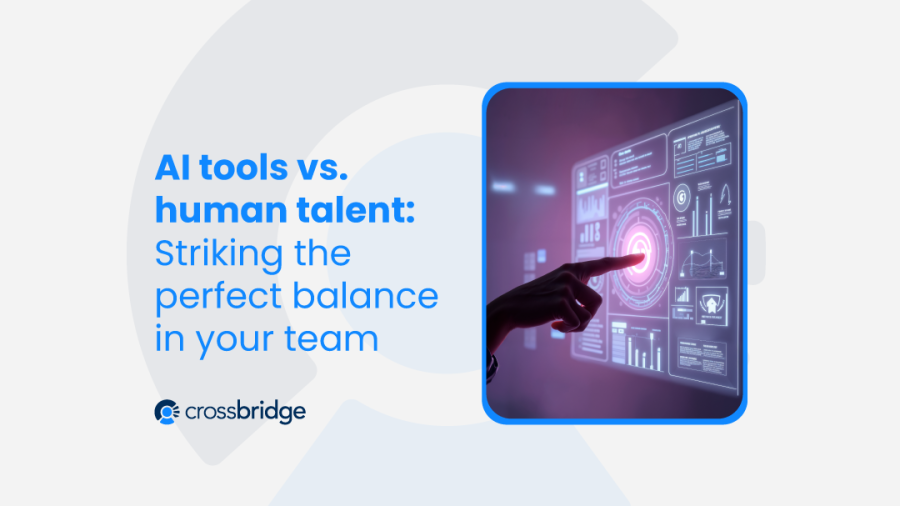The debate between artificial intelligence (AI) and human talent has been ongoing in the tech industry for some time. On one hand, AI tools promise enhanced efficiency, speed, and cost savings. On the other hand, creativity, critical thinking, and adaptability remain irreplaceable. So, how do tech teams strike the perfect balance between AI and human talent to boost productivity and drive innovation?
The rise of AI in tech: Automating repetitive tasks
AI is rapidly becoming a game changer for businesses, especially tech teams, by automating time-consuming, repetitive tasks. A study by McKinsey found that 60% of occupations could automate at least one-third of their activities, freeing up human workers to focus on tasks that require creativity, strategic thinking, and problem-solving.
With AI handling routine tasks such as data analysis, code generation, and troubleshooting, tech teams can shift their focus to more high-value areas like innovation and growth. The most common AI tools used in tech include:
• Natural Language Processing (NLP) tools for analyzing large volumes of unstructured text data
• Automated software testing to identify bugs and issues faster
• Predictive analytics tools to help make data-driven decisions
These tools help tech teams achieve more in less time, allowing them to keep pace in today’s fast-evolving market.
The human element: Creativity, adaptability, and emotional Intelligence
While AI can streamline processes, it cannot replicate the creativity and empathy that humans bring to the table. For innovation to truly flourish, companies need people who can think outside the box and bring fresh ideas to the forefront.
Humans excel at understanding complex problems in ways that AI cannot. Forbes notes that while AI is excellent at managing structured data, humans still outshine when it comes to interpreting ambiguous data and making judgment calls. Critical thinking and problem-solving abilities are areas where human talent outperforms AI, especially in tech fields where the ability to pivot and adapt to new challenges is vital.
Striking the balance: AI enhancing human potential
The sweet spot lies in combining AI tools with human talent to create a hybrid team. Here’s how you can find the balance between the two:
1. AI for efficiency, people for creativity: Let AI handle tasks that are repetitive, data-heavy, or require lightning-speed accuracy. Meanwhile, reserve humans for jobs that need creativity, emotional intelligence, and critical thinking.
2. Upskill your team for the future: Ensure your talent stays ahead of the curve by continuously learning new skills, especially in AI and machine learning. According to LinkedIn, AI skills have grown by 190% between 2015 and 2022, making it one of the most in-demand skill sets in tech.
3. Foster collaboration between AI and Humans: Encourage your team to embrace AI as a tool to enhance their work, not replace them. The combination of AI-powered tools and human ingenuity can lead to breakthroughs that wouldn’t be possible otherwise.
AI tools and human talent in action: Case Studies
Case Study 1: Netflix’s personalized recommendations
Netflix uses AI-powered algorithms to analyze user data and suggest personalized content recommendations. However, human talent plays a crucial role in creating the original content that users love. This balance between AI and creativity has helped Netflix maintain its leadership in the streaming industry.
Case Study 2: Tesla’s manufacturing process
Tesla combines AI and robotics with human oversight to streamline its production process. AI-driven robots handle repetitive assembly tasks with precision, while humans monitor quality and handle complex problem-solving to ensure everything runs smoothly.
Overcoming challenges: When AI falls short
Despite the advantages of AI, there are some challenges to keep in mind. AI tools are only as good as the data they are trained on, and if the data is biased or incomplete, it can lead to incorrect results. Human intervention is necessary to spot these issues and make critical adjustments. Gartner predicts that by 2025, 60% of AI implementations will struggle with explainability, emphasizing the need for human oversight in AI-driven decisions.
Conclusion: The future is hybrid
In tech teams, AI is not a replacement for human talent—it’s a partner. By leveraging AI tools to automate mundane tasks and allowing humans to focus on creative problem-solving, companies can boost productivity, drive innovation, and stay competitive. The future of tech workforces is a hybrid approach, where AI and humans work together to bring out the best in each other.
At Crossbridge Global Partners, we connect you with skilled professionals who can work seamlessly with AI to drive innovation and efficiency. Contact us today to build a team that’s equipped for the future.
Sources:
1. McKinsey & Company: The Future of Work
2. Forbes: AI vs. Human Intelligence
3. Gartner: AI Trends
4. LinkedIn: Skills of the Future
